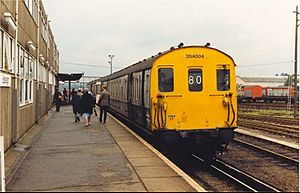British Rail Class 204 facts for kids
Quick facts for kids British Rail Class 204 |
|
|---|---|

204004 pictured on arrival at Eastleigh on 28 August 1986
|
|
| In service | 1957– |
| Formation | unknown |
| Operator(s) | British Rail |
| Specifications | |
| Maximum speed | unknown |
| Prime mover(s) | English Electric 4-cylinder type 4SRKT Mark II of 600 bhp (450 kW) at 850 rpm |
Imagine a train that can move all by itself, without needing a separate engine car to pull it along. That's what a Diesel Multiple Unit (DMU) is! The British Rail Class 204 trains were a special type of DMU used in the United Kingdom.
These trains were a shorter, two-car version of another popular train, the Class 205 '3H' units. They were known by the old system as '2H' units. Only a few of these trains were built, with unit numbers ranging from 1119 to 1122. They began their service in 1957, helping people travel across different parts of the country.
Contents
What is a Diesel Multiple Unit?
A Diesel Multiple Unit, or DMU, is a type of train that has its own engine built right into the passenger carriages. This is different from traditional trains where a separate engine (locomotive) pulls many carriages. DMUs are great because they can be easily joined together or separated to make longer or shorter trains, depending on how many passengers need to travel.
How DMUs Work
DMUs use diesel engines to create power. This power can either directly turn the wheels or generate electricity to power electric motors that turn the wheels. The Class 204 trains used a powerful English Electric engine. This engine could produce 600 horsepower, which is a lot of power for a train!
The Class 204's Design
The Class 204 trains were designed to be very similar to the Class 205 units. The main difference was that the Class 204 had only two carriages, while the Class 205 usually had three. This made the Class 204 perfect for routes that didn't need a very long train, like local services or quieter lines.
Why Two Cars?
Having only two cars made the Class 204 trains lighter and more agile. They could speed up and slow down quickly, which was useful for routes with many stops. They were also more fuel-efficient for smaller passenger loads.
Life on the Tracks
The Class 204 trains started their service in 1957. They were part of a big effort by British Rail to replace older steam trains with more modern and efficient diesel trains. These new trains helped make train travel faster, cleaner, and more comfortable for passengers.
Where Did They Run?
While the exact routes for the Class 204 are not always specified, similar DMUs were often used for local and regional passenger services. This means they would have carried people on shorter journeys, connecting towns and villages. They were a common sight on many lines across the British railway network.
The Legacy of the Class 204
Even though there were only a few Class 204 units, they played a part in the modernization of British railways. They showed how versatile and useful diesel multiple units could be. Many trains today still use similar ideas, with engines built into the passenger cars for efficient travel.

